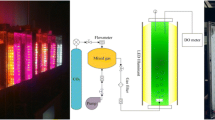Abstract
Three different azo dyes such as Fast red, metanil yellow and Fast orange were examined for their decolorization by O. oeni ML34. Fast red (FR) was decolorized by 68%, whereas the other dyes were removed by only about 30%. The effects of glucose addition, substrate (dye) concentration and environmental factors (temperature, pH) on decolorization were investigated by two-level factorial design. The statistical analyses revealed that glucose specifically increases the extent of FR decolorization. A glucose level of 5 g/l was the optimum concentration for removal of, FR reaching a decolorization percentage of up to 93%.





Similar content being viewed by others
References
Aksu Z (2005) Application of biosorption for the removal of organic pollutants: a review. Process Biochem 40:997–1026
Banat IM, Nigam P, McMullan G, Marchant R (1997) The isolation of thermophilic bacterial cultures capable of textile dyes decolorization. Environ Int 23:547–551
Bras R, Ferra IA, Pinheiro HM, Goncalves IC (2001) Batch tests for assessing decolorisation of azo dyes by methanogenic and mixed cultures. J Biotechnol 89:155–162
Chang J, Kuo T (2000) Kinetics of bacterial decolorization of azo dye with Escherichia coli NO3. Bioresour Technol 75:107–111
Chao WL, Lee SL (1994) Decolorizaton of azo dyes by three white rot fungi. Influence of carbon source. World J Microbiol Biotechnol 10:556–559
Dos Santos AB, Cervantes FJ, Van Lier JB (2007) Review paper on current technologies for decolorisation of textile wastewaters: perspectives for anaerobic biotechnology. Bioresour Technol 98:2369–2385
El-Helow ER, El-Ahawany A (1999) Lichenase production by catabolite repression-resistant Bacillus subtilis mutants: optimization and formulation of an agro-industrial by-product medium. Enzyme Microbiol Technol 24:325–331
El-Sersey N (2001) Microbial catabolism of some marine organic pollutants: the development of bioremediation system. PhD Thesis, Faculty of Science, Aexandria University
Haberer P, Du Toit M, Dicks LM, Ahrens F, Holzapfel WH (2003) Effect of potentially probiotic lactobacilli on faecal enzyme activity in minipigs on a high-fat, high-cholesterol diet—a preliminary in vivo trial. Int J Food Microbiol 87:287–291
Lepper HA (ed) (1950) Official methods of analysis, 7th edn. Association of official Analytical Chemists, Washington
Maynard CW (1983) Dye application, manufacture of dye intermediates and dyes. In: Kent JA (ed) Riegel’s hand book of industial chemistry, Van Nostrand Reinhold, New York, pp 809–861
McDowell EM, Trump BF (1976) Histologic fixative suitable for diagnostic light and electron microscopy. Arch Pathol Lab 10:405–413
Pandey A, Singh P, Lyengar L (2007) Bacterial decolorization and degradation of azo dyes. Int Biodeterior Biodegradation 59:73–84
Pearce CI, Lioyd JR, Guthrie JT (2003) The removal of colour from textile waste water using whole bacterial cells: a review. Dye Pigments 58:179–196
Pinheiro HM, Touraud E, Tomas O (2004) Aromatic amines from azo dye reduction: status review with emphasis on direct UV spectrophotometric detection in textile industry wastewaters. Dyes Pigments 61(2):121–139
Seesuriyachan P, Takenaka S, Kuntiya A, Klayraung S, Murakami S, Aoki K (2007) Metabolism of azo dyes by Lactobacillus casei TISTR 1500 and effects of various factors on decolorization. Water Res 41:985–992
Soomro AH, Masud T, Anwaar K (2002) Role of lactic acid bacteria in food preservation and human health. A review. Pak J Nut 1:20–24
Southern TG (1995) Technical solutions to the colour problem: a critical review. In: Cooper P (ed) Colour in dyehouse effluent. Society of Dyes and Colourists, Bradford, 75 pp
Talarposhti AM, Donnelly T, Anderson GK (2001) Colour removal from a simulated dye wastewater using two-phase anaerobic packed bed reactor. Water Res 35:425–432
Wong P, Yuen P (1996) Decolorization and biodegradation of methyl red by Klebsiella pneumoniae RS-13. Water Res 30:1736–1744
Yatmaz HC, Akyol A, Bayramoglu M (2004) Kinetics of Photocatalytic decolorization of an Azo Reactive Dye in aqueous ZnO suspensions. Ind Eng Chem Res 43:6035–6039
Zhou W, Zimmermann W (1993) Decolorization of industrial effluents containing reactive dyes by actinomycetes. FEMS Microbiol Lett 107:15–162
Zollinger H (1987) Colour chemistry-synthesis, properties and application of organic dyes and pigments. VCH publishers, New YorK, pp 92–102
Acknowledgement
My sincere gratitude to Prof. John Hershey at University of California, Davis and Prof. Soraya Sabry for their review of this manuscript. I would like also to thank Dr. David Mills at UC Davis for providing the O. oeni ML34 strain.
Author information
Authors and Affiliations
Corresponding author
Rights and permissions
About this article
Cite this article
El Ahwany, A.M. Decolorization of Fast red by metabolizing cells of Oenococcus oeni ML34. World J Microbiol Biotechnol 24, 1521–1527 (2008). https://doi.org/10.1007/s11274-007-9640-z
Received:
Accepted:
Published:
Issue Date:
DOI: https://doi.org/10.1007/s11274-007-9640-z




